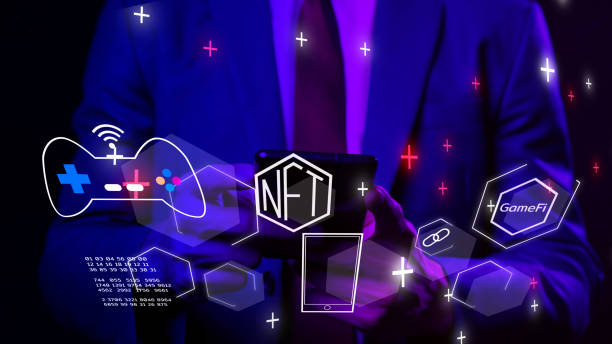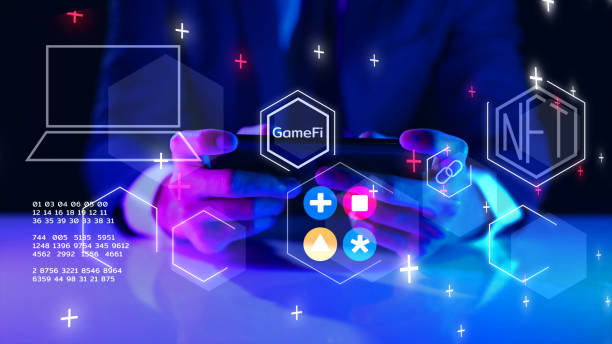GameFi, or play-to-earn in Web3 games, lets users earn tokens while playing, combining finance with gaming. GameFi refers to this financial gaming segment in decentralized apps.

Gaming on the blockchain has seen remarkable growth, thanks to technical innovations that allow in-game assets to be represented as blockchain tokens and NFTs. This shift has given rise to the play-to-earn (P2E) model, where players earn tokens for their in-game achievements. P2E gained popularity during the 2021 crypto bull market, with titles like Axie Infinity, The Sandbox, and Splinterlands experiencing substantial growth. However, it’s crucial to understand that P2E doesn’t guarantee returns.
The Evolution of Monetization: From Arcade Coins to Play-to-Earn (P2E)
In the history of game monetization, play-to-earn (P2E) is a recent chapter, but it’s part of a long journey. Back in the 1970s and 1980s, players had to insert coins into arcade machines to enjoy gaming. The transition from arcades to home consoles introduced the pay-to-play (P2P) model, where players purchased a title with a one-time fee for unlimited access.
However, the advent of smartphones and in-app purchases, notably by Apple, disrupted the P2P model. This shift led to the rise of the “freemium” approach in mobile gaming, allowing users to play a basic version for free and enhance their experience through in-game upgrades.
Play-to-earn (P2E) represents the latest phase in this evolution, offering a unique twist by enabling ownership of in-game items. While a robust GameFi ecosystem emerged around 2020, P2E gained early traction in the crypto community with the launch of CryptoKitties on the Ethereum blockchain in 2017.
Today, GameFi is one of the fastest-growing segments in the digital asset space, attracting investments from major game studios like Epic Games, Ubisoft, and Nintendo.
Distinctive Characteristics of GameFi
The realm of play-to-earn (P2E) games boasts a rich tapestry of rules, earning mechanisms, staking strategies, and reward systems that vary significantly from one game to another. Nevertheless, several common features bind them together.
Asset Ownership via Blockchain Technology:
GameFi operates on blockchain networks, where various in-game elements are represented as blockchain-based tokens.
Fungible tokens function as in-game currencies, facilitating transactions and purchases within the gaming environment.
Non-fungible tokens (NFTs) take center stage, representing exclusive or scarce in-game assets such as digital real estate, avatar skins, treasured items, and formidable weaponry.
These tokens can be freely traded outside of the game on cryptocurrency exchanges and NFT marketplaces, providing gamers with opportunities to buy, sell, and exchange in-game assets across platforms. For instance, Ethereum-based games find a home on OpenSea, while Solana-based titles thrive on Magic Eden.
Innovative GameFi Components: Blending DeFi, DAO Governance, and Guilds
Within the diverse landscape of GameFi, certain projects are introducing elements borrowed from decentralized finance (DeFi), thus creating unique and engaging experiences. Let’s explore some of these distinctive facets:
DeFi Integration:
Some GameFi endeavors seamlessly integrate DeFi features like staking and yield farming into their gameplay mechanics. A prime illustration is Aavegotchi, where users foster their digital companions by staking Aave’s tokens to enhance their market value. This process involves nurturing specific traits that bolster the characters’ prowess within the game.
DAO Governance:
Some GameFi projects use DAOs (Decentralized Autonomous Organizations) for decentralized governance, like Decentral Games in the Polygon blockchain ecosystem. It’s worth noting that not all GameFi projects adopt DAO governance, and some centralized companies participate in play-to-earn game development.
GameFi Guilds:
GameFi guilds, inspired by MMORPG communities, blend gaming camaraderie with financial aspects. Members can share winnings and support new players. Yield Guild Games is a prime example of a P2E gaming guild organized as a DAO, fostering an immersive and collaborative gaming environment.
Some Risks and Controversies Involved in GameFi
As GameFi continues to gain traction, it’s crucial for users to exercise vigilance and be cognizant of potential risks.
In March 2022, Axie Infinity, a prominent P2E title, faced a significant setback when it fell victim to a major hacking incident. Over 170,000 ETH, valued at nearly $600 million, were pilfered. The breach targeted Sky Mavis, the company behind the game, and exploited their access to compromise the Ronin bridge, which connects the Axie ecosystem to the Ethereum blockchain. This event had a notable impact on the game’s popularity, and despite its efforts, Axie Infinity struggled to regain its former prominence in the increasingly competitive GameFi arena.
Just a month later, in April 2022, WonderHero suffered a hacking incident resulting in losses of $300,000. The project’s token depreciated so rapidly that it compelled the suspension of all services.
These incidents serve as a stark reminder of the relative youth and vulnerability of the GameFi space, prompting cybersecurity experts to caution against potential cyber threats.
Furthermore, GameFi projects may face regulatory scrutiny, potentially leading to fines or even involuntary closures. In the event of regulatory action, users may find themselves unable to access their assets, particularly if front-end interfaces are disabled. Consequently, these assets could rapidly lose value without an active game supporting their utility.
Lastly, it’s essential to acknowledge the various restrictions governing the trading of GameFi tokens, stemming from a combination of exchange policies and regulatory frameworks.
Learn from market wizards: Books to take your trading to the next level

 Hot Features
Hot Features














